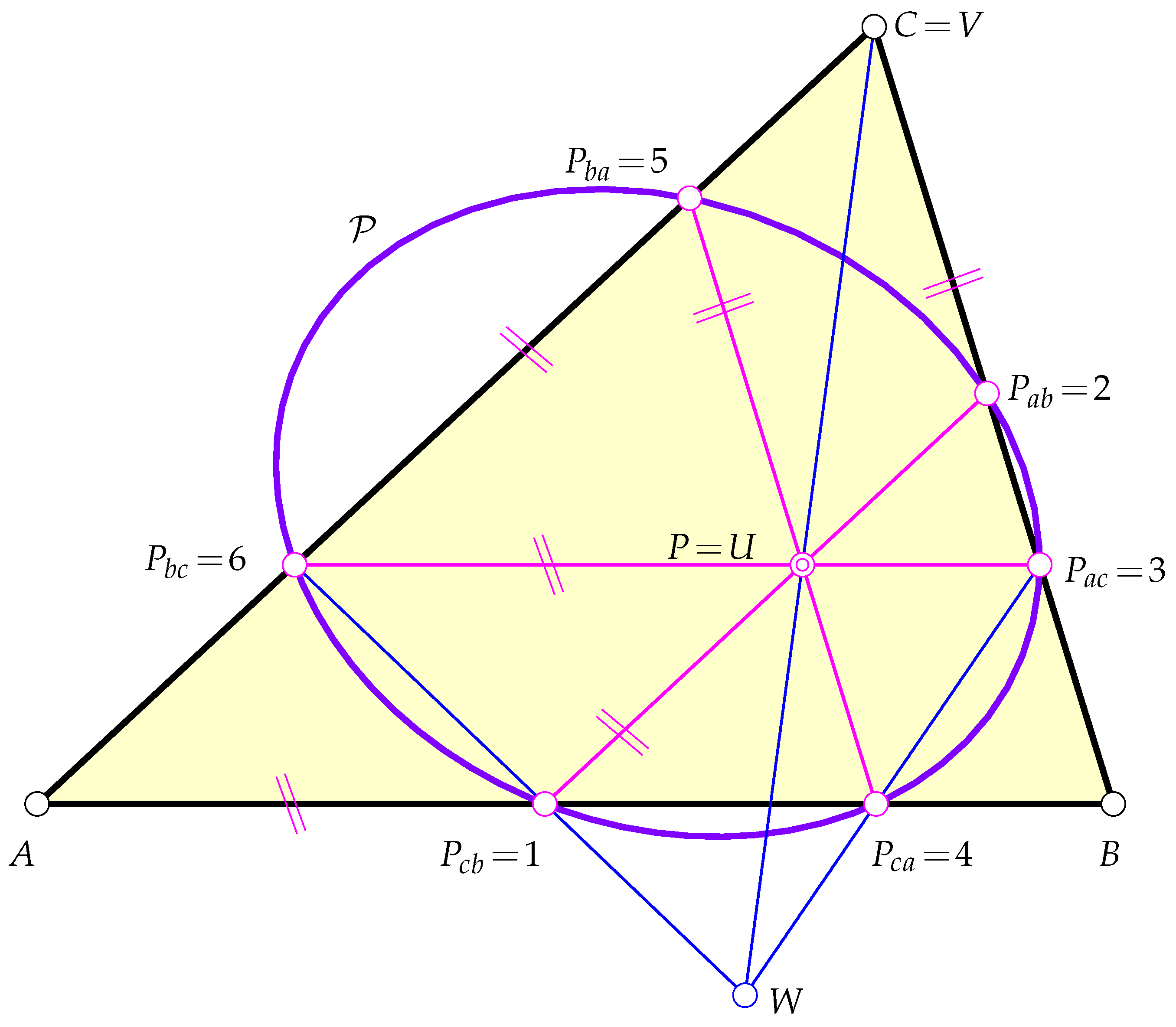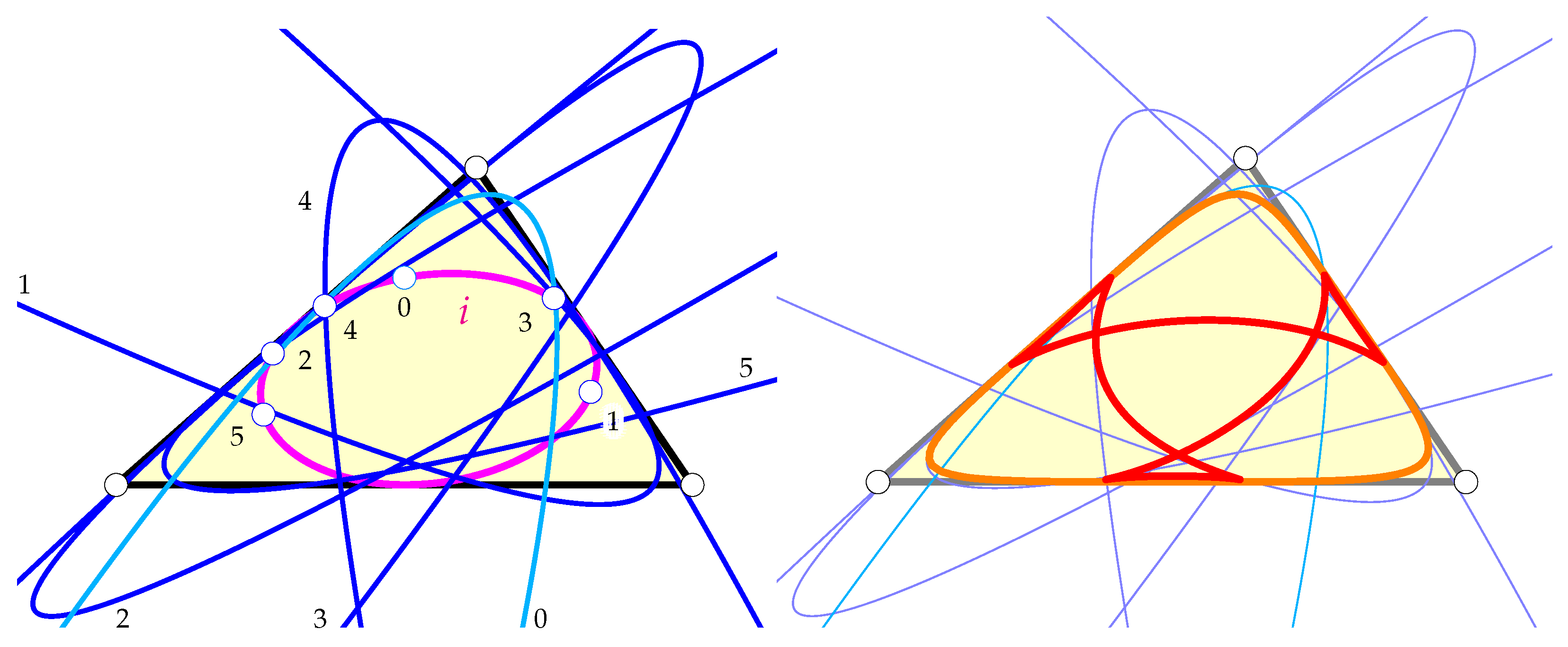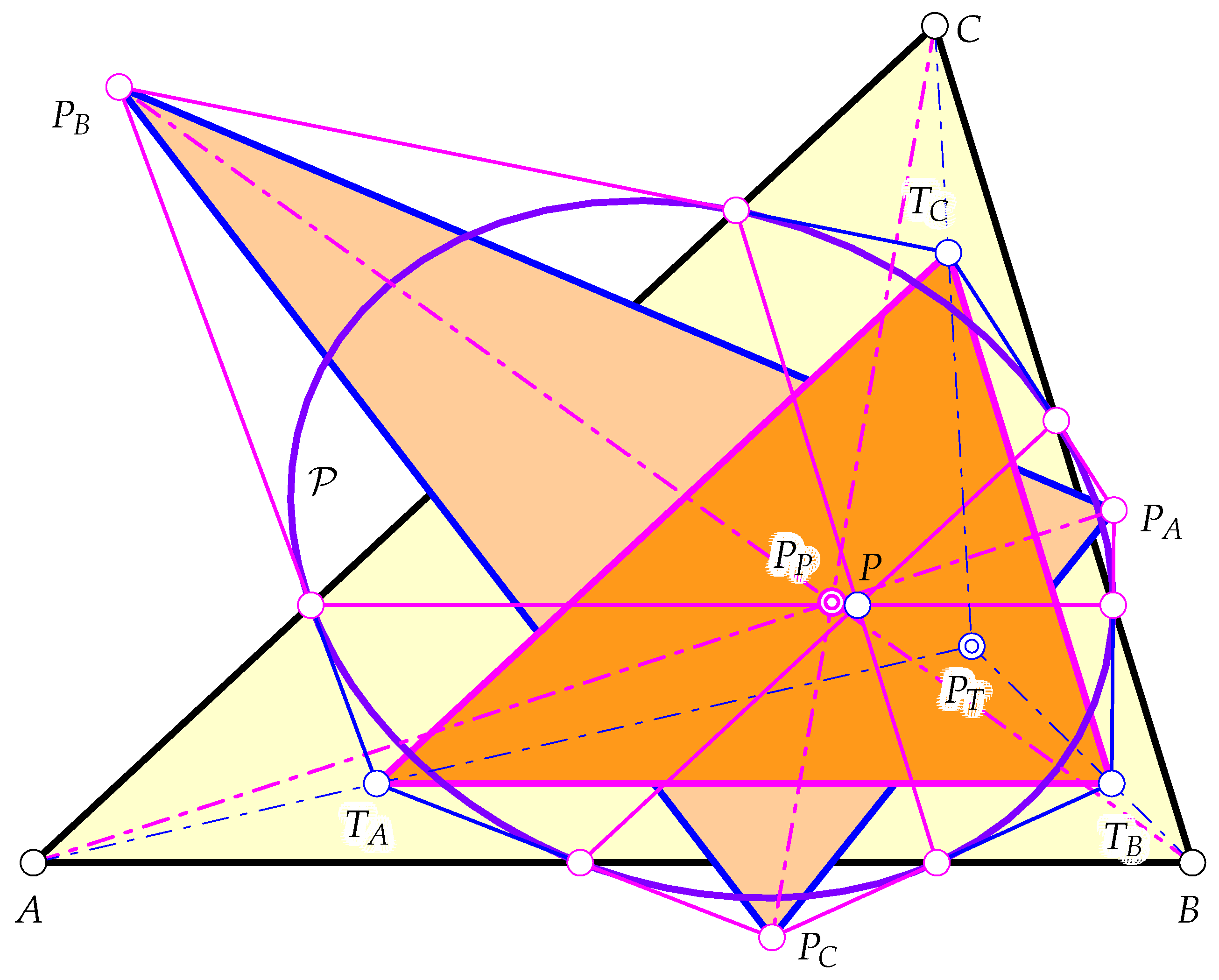Conics and Transformations Defined by the Parallelians of a Triangle
Abstract
1. Introduction
2. The Parallelian Conic and Inconic
2.1. The Shape of the Parallelian Conic
- 1.
- The parallelian conic is an equilateral hyperbola if, and only if, the pivot point P is chosen on the central line .
- 2.
- The equilateral hyperbola becomes the repeated ideal line if .
- 3.
- The centers of the equilateral hyperbolae gather on a triangle cubic.
- A conic is an equilateral hyperbola if, and only if, its ideal points correspond to orthogonal directions. The intersections of and are given bywhere and as defined in (2). The asymptotes of are the lines and , with being the center of (i.e., the pole of the ideal line with regard to ). According to [3] (p. 22), the lines and are orthogonal if, and only if, withwhere , are non-trivial multiples of either of the homogeneous triples given in (5). Note that, for , , and , we set the rational expressions from (4). This yielded the following linear form:where , , and are replaced with x, y, and z. The latter form is the homogeneous trilinear equation of the line joining and . (This line further contains the triangle centers , , and ).On the other hand, if we choose a point on for a pivot point and determine the parallelian conic, we find that becomes an equilateral hyperbola.
- The second statement can be shown by inserting the trilinears of into (1), or it follows from Theorem 1, since .
- Inserting a parametrization of with into the trilinear representation of the centers of yields a parametrization of a cubic curve, and an implicitization shows that the cubic is a triangle cubic (i.e., it has a cyclically symmetric trilinear equation).
2.2. Inconic of the Parallelian Hexagon
- 1.
- The pair of conics allows for a porism of hexagons.
- 2.
- The pair spans an exponential pencil of conics in which any pair of subsequent conics allows for a hexagonal porism.
- This is clear from the definition of exponential pencils (cf. [8]).
3. Tangent Triangles and Hexagons
- 1.
- Each of the pairs of conics and allows for a poristic family of interscribed hexagons.
- 2.
- Both pairs of conics span the same exponential pencil of conics, and therefore, they define the same one-parameter family of nested hexagonal porisms.
- The first part of the theorem is clear, simply because of the existence of interscribed hexagons.
- In order to verify that the coefficient matrices , , and of the respective conics satisfy (which is the representation of the coefficient matrix of the conic following and in the (discrete) exponential pencil), one can extract the coefficient matrices from the equations. The scalar depends on a, b, and c (i.e., the triangle) and the pivot point P solely and turns out to be . On the other hand, by construction, is the polar image of with respect to , which is expressed algebraically by this matrix equation.
- 1.
- The vertices of and are located on a single conic and the pair of conics allows for a triangle porism.
- 2.
- The pair allows for a hexagonal porism.
- 3.
- The pair spans an exponential pencil of conics, and thus, they define a one-parameter family of nested hexagonal porisms.
- The vertices of and areand the conic on these six points has the trilinear equationThe existence of at least one triangle tangent to (either or ) and inscribed into is sufficient for the existence of a triangle porism.
- The second part of the theorem is shown with the Cayley criterion for pairs of conics as given in [5] (p. 432).
- The last part of the proof can be deduced in the same way as the proof of Theorem 7.
- 1.
- The hexagon is tangent to a circumconic of Δ.
- 2.
- The pair of conics allows for a porism of hexagons.
- 3.
- The pairs of conics allows for a porism of triangles.
- 4.
- The pairs of conics from 2. and 3. define chains of nested triangle and hexagon porisms.
- It is easily verified that the sides of the hexagon touch the conic given by the equationIt is obvious that passes through the vertices of .
- This is clear, since is a hexagon interscribed between the respective conics.
- Since is circumscribed to and is inscribed into , there exists a (smooth) one-parameter family of such triangles.
- We use the arguments from the proof of Theorem 7.
4. Some Algebraic Transformations
4.1. Perspectors of Triangles
4.2. Centers of Conics
5. Conclusions and Future Work
Author Contributions
Funding
Data Availability Statement
Conflicts of Interest
References
- Bier, S. Equilaternal triangles intercepted by oriented parallelians. Forum Geom. 2001, 1, 25–32. [Google Scholar]
- Gibert, B.; van Lamoen, F.M. The Parasix Configuration and Orthocorrespondence. Forum Geom. 2003, 3, 169–180. [Google Scholar]
- Kimberling, C. Triangle Centers and Central Triangles; Congressus Numerantium Vol. 129; Utilitas Mathematica Publishing: Winnipeg, MB, Canada, 1998. [Google Scholar]
- Kimberling, C. Encyclopedia of Triangle Centers. Available online: https://faculty.evansville.edu/ck6/encyclopedia/ETC.html (accessed on 10 October 2025).
- Stachel, H.; Glaeser, G.; Odehnal, B. The Universe of Conics. From the Ancient Greeks to 21st Century Developments; Springer: Berlin/Heidelberg, Germany, 2024. [Google Scholar]
- Tucker, R. The Triplicate Ratio Circle. Q. J. Pure Appl. Math. 1883, 19, 342–348. [Google Scholar]
- del Centina, A. Poncelet’s Porism: A long story of renewed discoveries I. Arch. Hist. Exact Sci. 2016, 70, 1–122. [Google Scholar] [CrossRef]
- Halbeisen, L.; Hungerbühler, N. The exponential pencil of conics. Beitr. Algebra Geom. 2018, 59, 549–571. [Google Scholar] [CrossRef]
- Odehnal, B. Mixed intersections of Cevians and perspective triangles. In Proceedings of the 15th International Conference on Geometry and Graphics, Montreal, QC, Canada, 1–5 August 2012; p. 090. [Google Scholar]
- Gibert, B. Cubics in the Triangle Plane. Available online: http://bernard-gibert.fr (accessed on 10 October 2025).
- Weiss, G.; Odehnal, B. Miquel’s theorem and its elementary geometric relatives. KoG 2024, 28, 11–24. [Google Scholar] [CrossRef]
- Odehnal, B. Universal Porisms and Yff Conics. KoG 2024, 28, 25–39. [Google Scholar] [CrossRef]





| i | 1 | 2 | 3 | 4 | 6 | 7 | 98 | 190 | 523 |
| j | 10013 | 2 | 64842 | 8801 | 10014 | 57826 | 4590 | 1016 | 36955 |
| i | 1 | 2 | 3 | 4 | 5 | 6 | 7 | 8 | 9 |
| j | 6 | 2 | 577 | 393 | 36412 | 32 | 279 | 346 | 220 |
| i | 10 | 13 | 14 | 19 | 20 | 21 | 22–29 | 30 | 31 |
| j | 594 | 11080 | 11085 | 2207 | 36413 | 7054 | 36414–36421 | 3163 | 1501 |
| i | 32 | 36 | 37 | 38 | 39 | 42 | 43 | 44 | 49 |
| j | 9233 | 52059 | 1500 | 8041 | 59994 | 7109 | 53145 | 1017 | 14585 |
| i | 55 | 56 | 57 | 63 | 69 | 74 | 75 | 76 | 81 |
| j | 14827 | 52410 | 1407 | 394 | 3926 | 40353 | 76 | 1502 | 593 |
| i | 1 | 2 | 3 | 4 | 5 | 6 | 7 | 8 | 9 | 10 |
| j | 1001 | 2 | 182 | 10002 | 10003 | 182 | 10004 | 10005 | 1001 | 3842 |
| i | 11 | 13 | 14 | 20 | 25 | 36 | 38 | 54 | 55 | 68 |
| j | 10006 | 10217 | 10218 | 47381 | 42820 | 3842 | 10007 | 42834 | 42828 | 10008 |
| i | 1 | 2 | 3 | 4 | 5 | 6 | 7 | 8 |
| j | 1125 | 2 | 140 | 5 | 3628 | 3589 | 142 | 59612 |
| i | 9 | 10 | 11–18 | 19 | 20 | 21 | 22 | 23 |
| j | 6666 | 3634 | 6667–6674 | 40530 | 3 | 6675 | 6676 | 468 |
| i | 24 | 25 | 26 | 27 | 28 | 29 | 30 | 31 |
| j | 16238 | 6677 | 10020 | 6678 | 52259 | 52260 | 30 | 6679 |
| i | 32 | 33–35 | 36 | 37 | 38–40 | 41 | 42–44 | |
| j | 6680 | 58402–58404 | 6681 | 4698 | 6682–6684 | 31248 | 6685–6687 | |
| i | 45 | 46 | 47 | 48 | 49 | 50 | 51 | 52 |
| j | 31285 | 58405 | ? | 58406 | 58407 | ? | 6688 | 5462 |
| i | 53 | 54–58 | 59 | 60 | 61 | 62 | 63 | |
| j | 58408 | 6689–6693 | 40531 | ? | 6694 | 6695 | 5745 | |
| i | 64 | 65 | 66 | 67 | 68 | 69 | 70 | 71 |
| j | 6696 | 3812 | 6697 | 6698 | 5449 | 141 | 58409 | 58410 |
| i | 72 | 73 | 74 | 75 | 76 | 77 | 78–81 | |
| j | 5044 | 58411 | 6699 | 3739 | 3934 | 58412 | 6700–6703 | |
| i | 82 | 83–86 | 87 | 88–90 | 91 | 92 | ||
| j | 5044 | 6704–6707 | ? | 58413–58415 | ? | 6708 | ||
| i | 93 | 94 | 95 | 96 | 97 | 98 | 99 | 100 |
| j | ? | 58416 | 6709 | ? | 58417 | 6036 | 620 | 3035 |
| i | 1 | 2 | 3 | 4 | 5 | 6 | 7 | 8 |
| j | 3 | 2 | 1147 | 6523 | 6663 | 206 | 17113 | 6552 |
| i | 9 | 10 | 11 | 19 | 31 | 32 | 37 | 39 |
| j | 6600 | 4075 | 64440 | 15259 | 40368 | 40369 | 40607 | 52042 |
| i | 57 | 63 | 65 | 69 | 75 | |||
| j | 6609 | 6503 | 15267 | 6338 | 6374 |
Disclaimer/Publisher’s Note: The statements, opinions and data contained in all publications are solely those of the individual author(s) and contributor(s) and not of MDPI and/or the editor(s). MDPI and/or the editor(s) disclaim responsibility for any injury to people or property resulting from any ideas, methods, instructions or products referred to in the content. |
© 2025 by the authors. Licensee MDPI, Basel, Switzerland. This article is an open access article distributed under the terms and conditions of the Creative Commons Attribution (CC BY) license (https://creativecommons.org/licenses/by/4.0/).
Share and Cite
Koncul, H.; Odehnal, B.; Božić Dragun, I. Conics and Transformations Defined by the Parallelians of a Triangle. Mathematics 2025, 13, 3424. https://doi.org/10.3390/math13213424
Koncul H, Odehnal B, Božić Dragun I. Conics and Transformations Defined by the Parallelians of a Triangle. Mathematics. 2025; 13(21):3424. https://doi.org/10.3390/math13213424
Chicago/Turabian StyleKoncul, Helena, Boris Odehnal, and Ivana Božić Dragun. 2025. "Conics and Transformations Defined by the Parallelians of a Triangle" Mathematics 13, no. 21: 3424. https://doi.org/10.3390/math13213424
APA StyleKoncul, H., Odehnal, B., & Božić Dragun, I. (2025). Conics and Transformations Defined by the Parallelians of a Triangle. Mathematics, 13(21), 3424. https://doi.org/10.3390/math13213424






